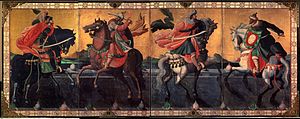Nanban art


Society of Jesus. Azuchi–Momoyama period, 16th century, Kyushu National Museum
Nanban art (南蛮美術) refers to
Nanban trade period, the word took on a new meaning when it came to designate the Portuguese, who first arrived in 1543, and later other Europeans. The term also refers to paintings which Europeans brought to Japan.[3][4]
History
Nanban art developed after the first Portuguese ships arrived in
persecution and prohibition of Christianity from the end of the sixteenth century and the Tokugawa policy of sakoku
, which largely closed Japan to foreign contact from the 1630s, Nanban art declined.
[3][6]
-
Painting from Momoyama period (1573-1615) by Hasegawa Nobukata of a European woman playing a viola de mano.
-
Hasegawa Nobukata painting of a religious man with children. Edo period, early 17th century.
-
Screen painting of foreign ship and Europeans in Japan.
-
Hasegawa Nobukata painting of two "Western warriors." Edo period, early 17th century.
-
Namban art, screen painting, circa 1600.
Reverse influence
While
Colonial Mexico
.
makie
.
This was derived from the trade in Japanese crafts through the Manila Galleons, which traveled between Manila (Philippines) to Acapulco (Mexico) from 1565 to 1815.[7]
Museums with collections of Nanban art
- Kobe City Museum[8]
- Museu Nacional de Arte Antiga[9]
- Museu do Oriente, Lisbon
See also
- Nanban trade
- Kirishitan
- Hasekura Tsunenaga
- Japanese words of Portuguese origin
- Yamato-e
- Nanman
References
Wikimedia Commons has media related to Nanban art.
- ^ a b 南蛮屏風 Kobe City Museum
- ^ 泰西王侯騎馬図 Kobe City Museum
- ^ ISBN 0-8348-1008-5.
- ^ "Nanban-e". Japanese Architecture and Art Net Users System. Retrieved 28 March 2011.
- ISSN 2254-8718.
- ^ "Nanban-byoubu". Japanese Architecture and Art Net Users System. Retrieved 28 March 2011.
- ISBN 978-84-7506-693-6.
- ^ "Kobe City Museum e-guide" (PDF). Kobe City. Retrieved 28 March 2011.
- Museu Nacional de Arte Antiga. Archived from the originalon 20 May 2011. Retrieved 28 March 2011.
bibliography
(en) Alexandra Curvelo, Nanban Folding Screen Masterpieces, Chandeigne, 2015 (978-2-36732-121-9)
(pt) Alexandra Curvelo, Obras-primas dos biombos Nanban, Japão-Portugal século XVII, Chandeigne, 2015 (
ISBN 978-2-36732-120-2
)





